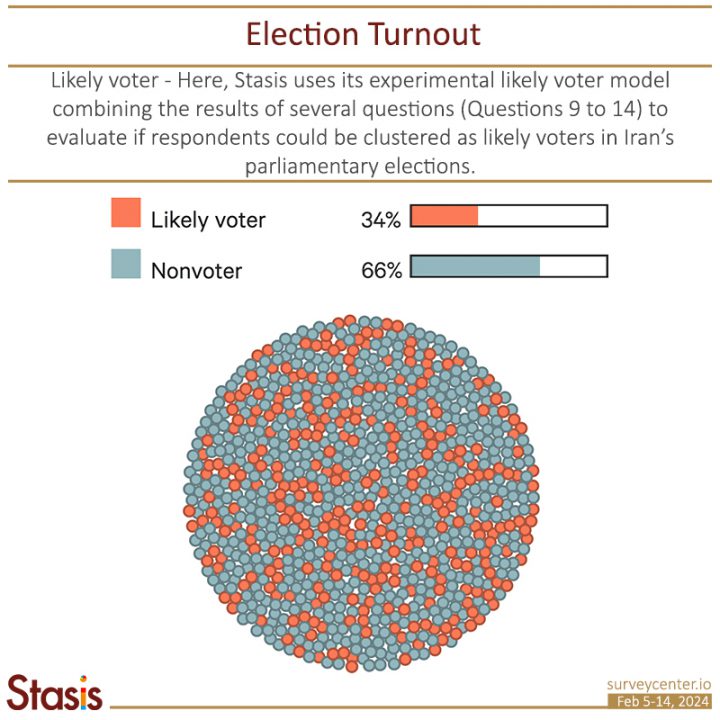
Polling suggests Iran’s 2024 Parliamentary Election Will See Record Low Turnout
Stasis Consulting: The latest survey from Statis Consulting predicts a record low turnout among Iranians in the March 1 parliamentary election of 34%. According to this survey, the majority of Iranians disapprove of President Ebrahim Raisi’s job performance as well as that of the parliament (65% and 61%, respectively). Moreover, in a hypothetical presidential face-off between President Raisi and former Foreign Minister Javad Zarif, Mr. Raisi wins out over Mr. Zarif 30% to 16%. This information is based on a representative poll conducted by Stasis Consulting between Feb. 5 and Feb. 14, 2024.
Parliamentary Election Turnout Stands at 34%
According to Stasis’ likely voters model, only 34% of the electorate is likely to vote in the upcoming parliamentary election on March 1 — a record low and around 9% less than the turnout in the previous parliamentary election in 2020.
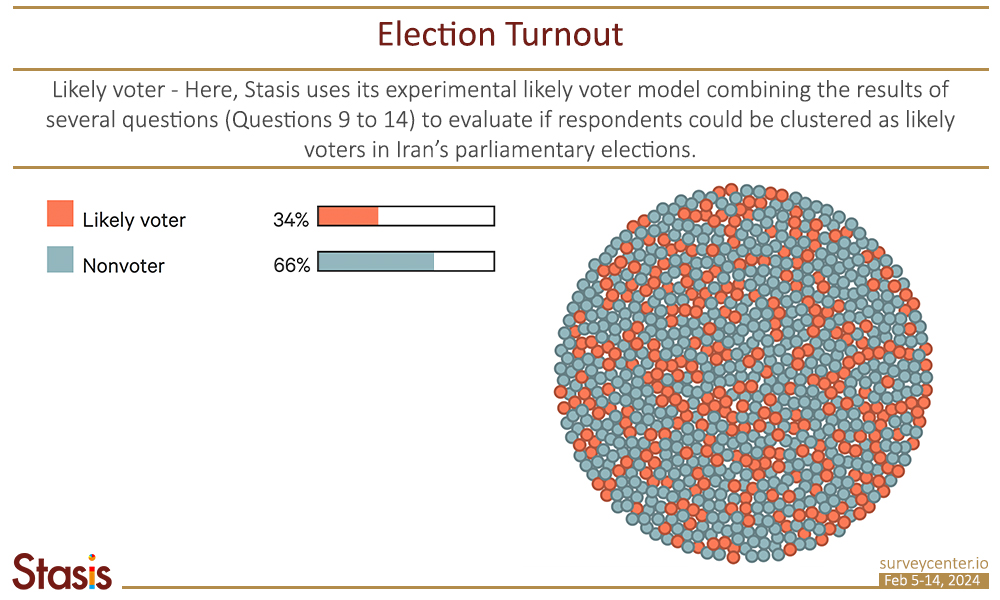
In this election, there is a significant disparity between the rates of likely voter participation based on two key demographic variables: age and education.
Just 19% of Iranian youth (aged 18-29) are highly likely to vote.
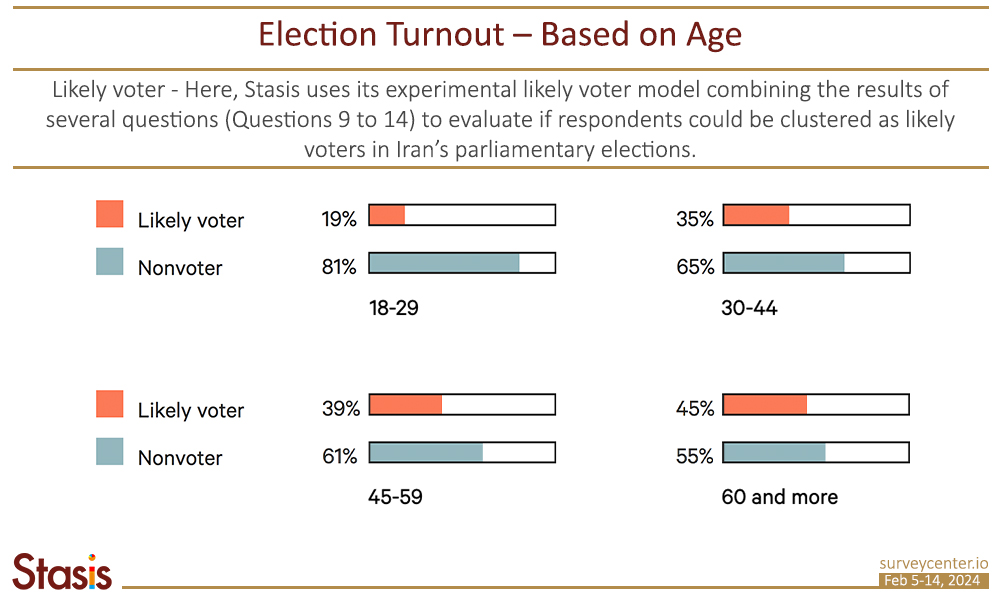
For the first time, expected voter turnout is predicted to be lower among less-educated Iranians compared to their more highly educated counterparts.
One of the most surprising findings among the survey results is that respondents without a college education say they are less likely to participate in the election (31%) than those with a college degree (40%). Historically, Stasis polling has tracked the opposite relationship between education level and voter participation rates, meaning that respondents who had earned a college degree have been less likely to vote than those who have not.
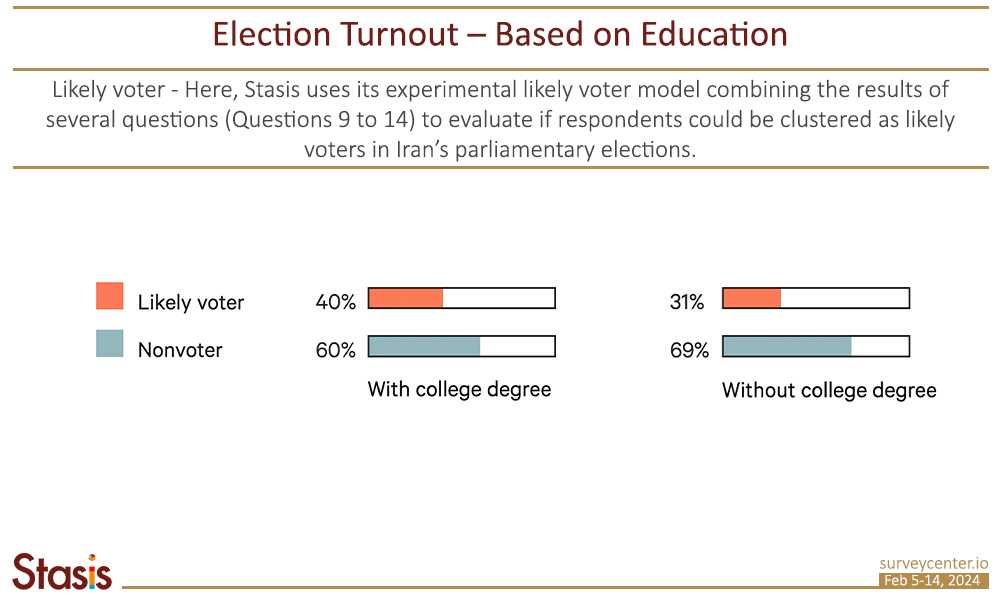
There may be several different reasons for the low turnout this election cycle, including the “Woman Life Freedom” movement in 2022 or the uprisings in 2017 and 2019, all of which involved many marginalized citizens, including those without access to college education. However, determining the exact causes of this trend is beyond the scope of this survey.
Lack of faith in candidates and the government are among the main reasons listed by those who do not plan to participate in the upcoming election.
The survey also tracks the main reasons that respondents may decline to participate in the election via an open-ended question. Among those respondents who reported they are not very confident that they will vote (n=683), 20% said it was because they don’t trust the candidates, 17% said it was because they don’t trust the government, and the same number claimed it was because they believe their votes or parliament’s decisions simply don’t matter.
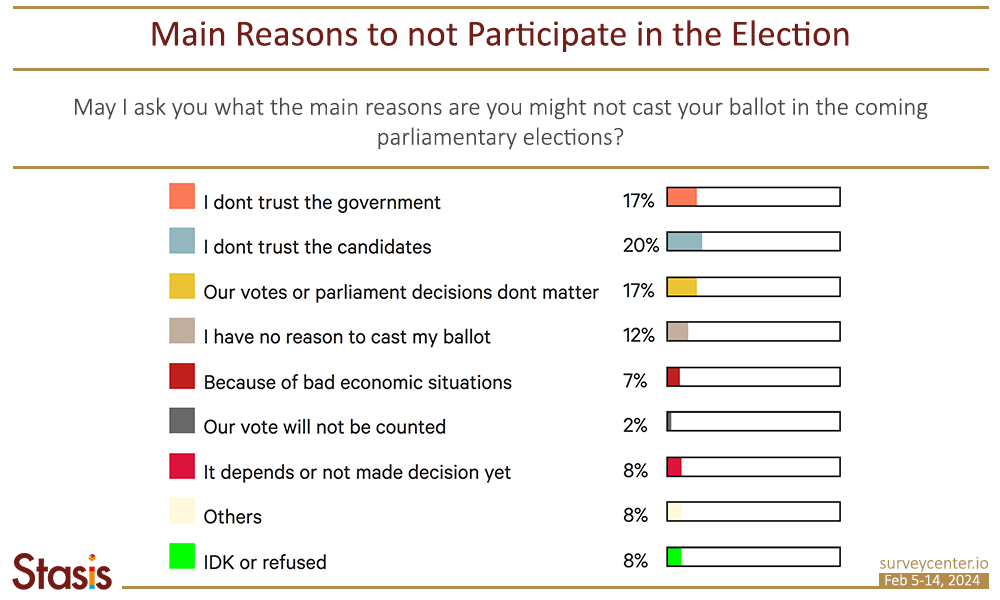
Presidential job approval is low at 32%
The results of this poll also indicate an overall disapproval of Mr. Raisi in his third year in office as president of the Islamic Republic. Only 32% of Iranians approve of his job performance while 65% disapprove of it, which includes 49% who strongly disapprove of his job performance. Although Mr. Raisi’s presidential job approval is low, this represents a 4-point improvement over 2022 findings.
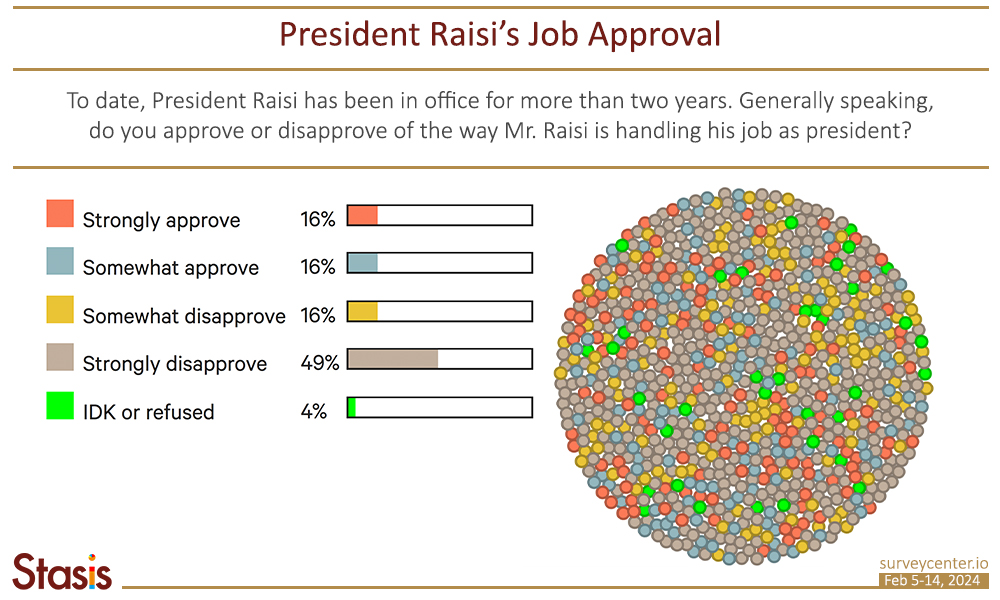
The president’s job approval rating varies somewhat across age demographics. Younger Iranians were more likely to say that they disapprove of President Raisi’s performance than older generations. Only 24% of Iranians aged 18- 29 approve of his job performance as opposed to 34% among those aged 30+. Disapproval of President Raisi’s job performance among Iranian youth is 73%, higher than for any other age group.
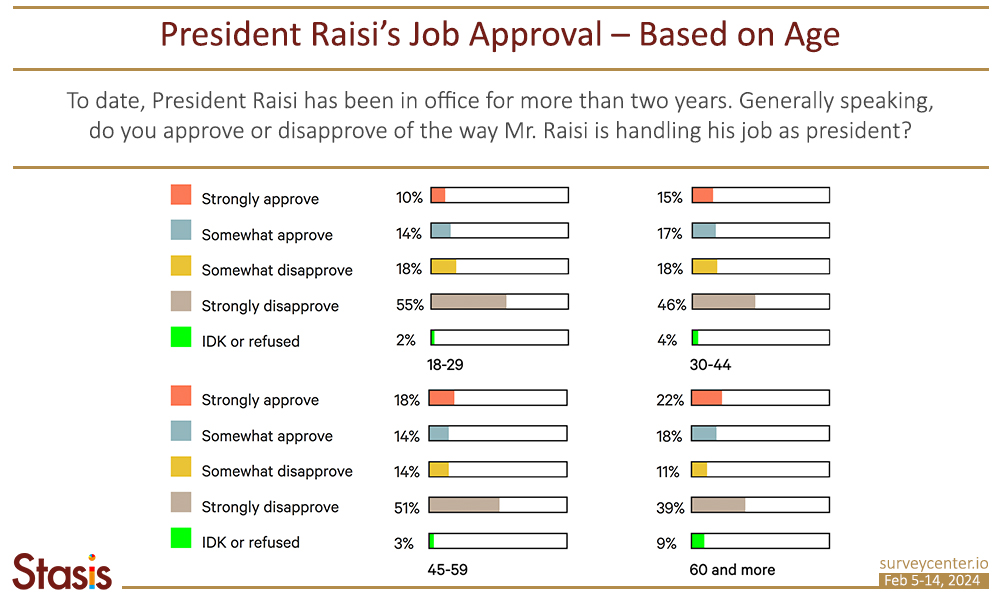
Iranians also disapprove of the way the current parliament is handling its job. Just 30% of Iranians approve of its performance as opposed to 61% who disapprove.
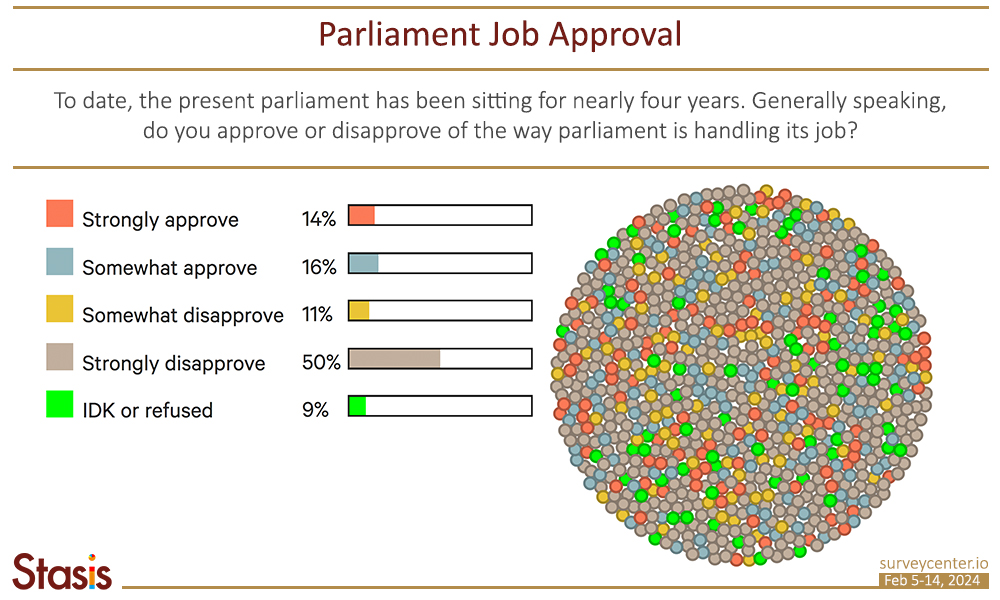
Raisi beats Zarif in a hypothetical presidential election, 30% to 16%
President Raisi beats former Foreign Minister Zarif in a hypothetical presidential election, by a shrinking margin. If they were to face off today, 30% of Iranians would choose Mr. Raisi against 16% for Mr. Zarif. The difference between these two potential candidates is less drastic among young Iranians than in the general population: 24% of respondents aged 18-29 would support Mr. Raisi while 20% prefer Mr. Zarif.
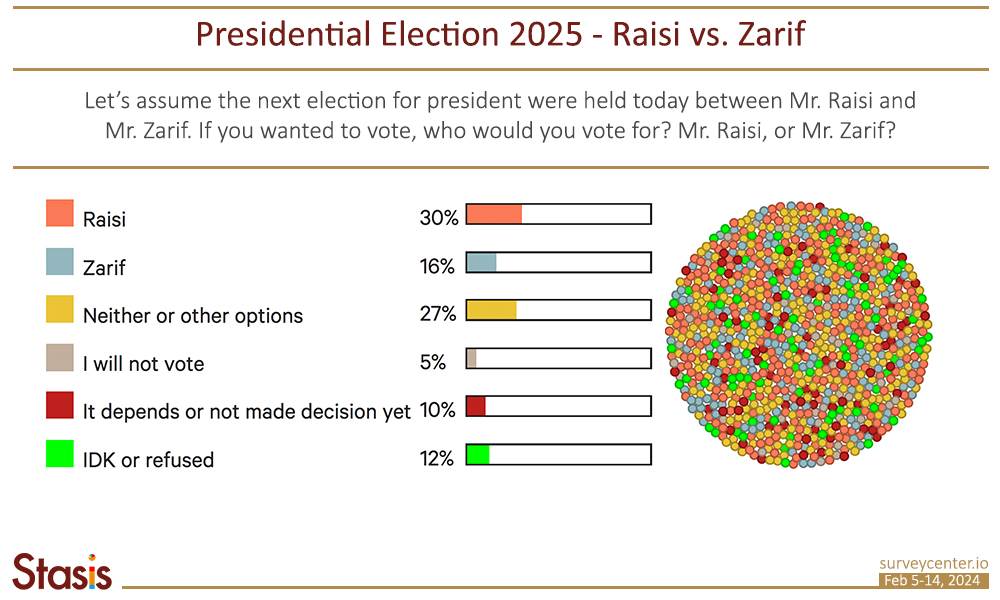
Although there is a double-digit gap in favor of Mr. Raisi, the numbers are better for Mr. Zarif compared with the last time Stasis polled Iranian citizens on this question. In May 2021, approximately one month before the last presidential election, 65% respondents selected Mr. Raisi and just 11% chose Mr. Zarif.
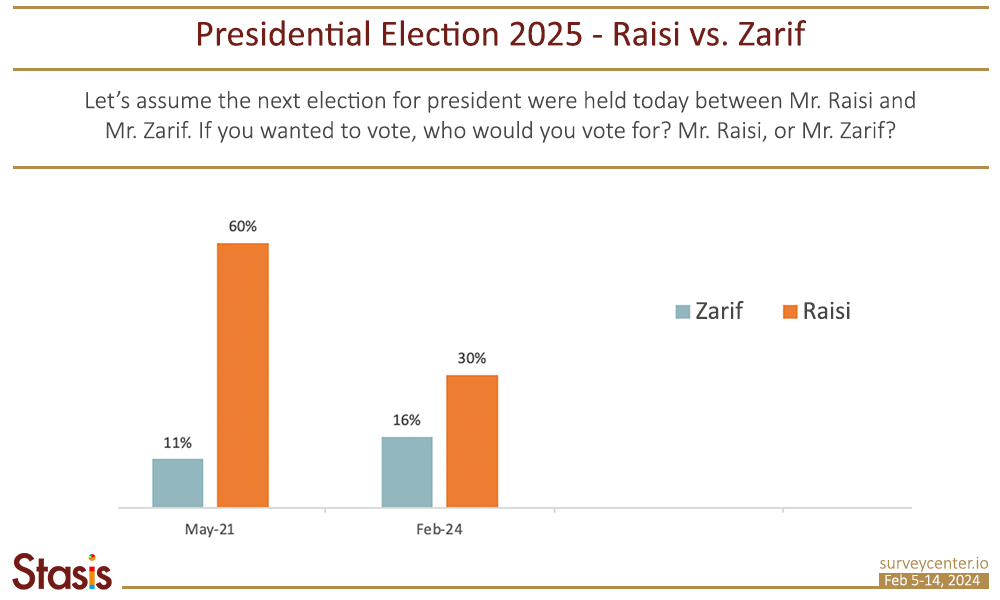
Iranian youth have serious concerns about their futures
In this survey, most respondents said that they are pessimistic about the future prosperity of the nation’s youth (76%), and most Iranians believe that young people would rather emigrate than stay in the country (68%). Respondents aged 18 to 29 are even more concerned about the prospects for future prosperity among Iranian youth (82%) and more likely to believe young people want to emigrate rather than stay in Iran (77%).
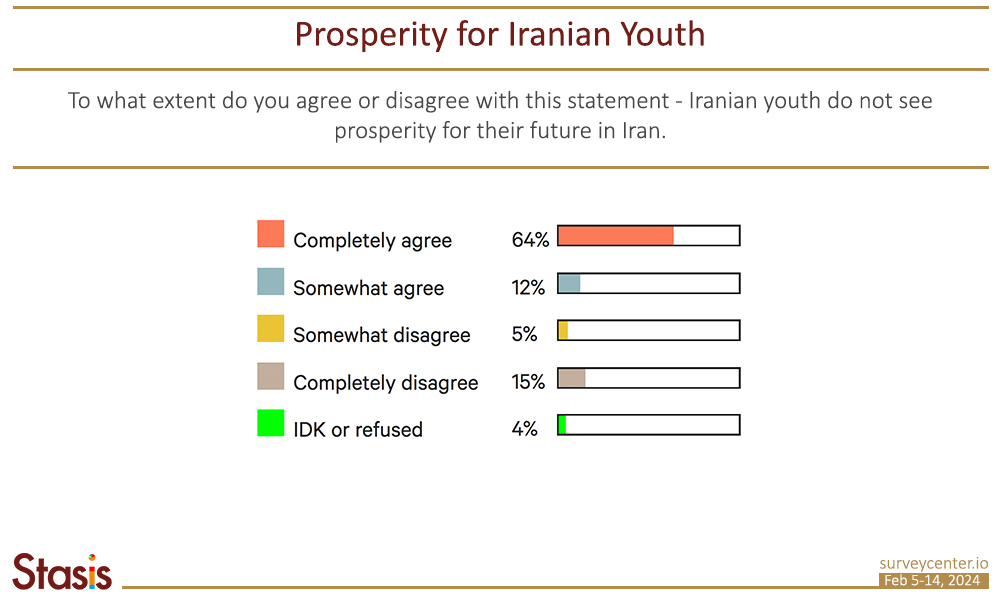
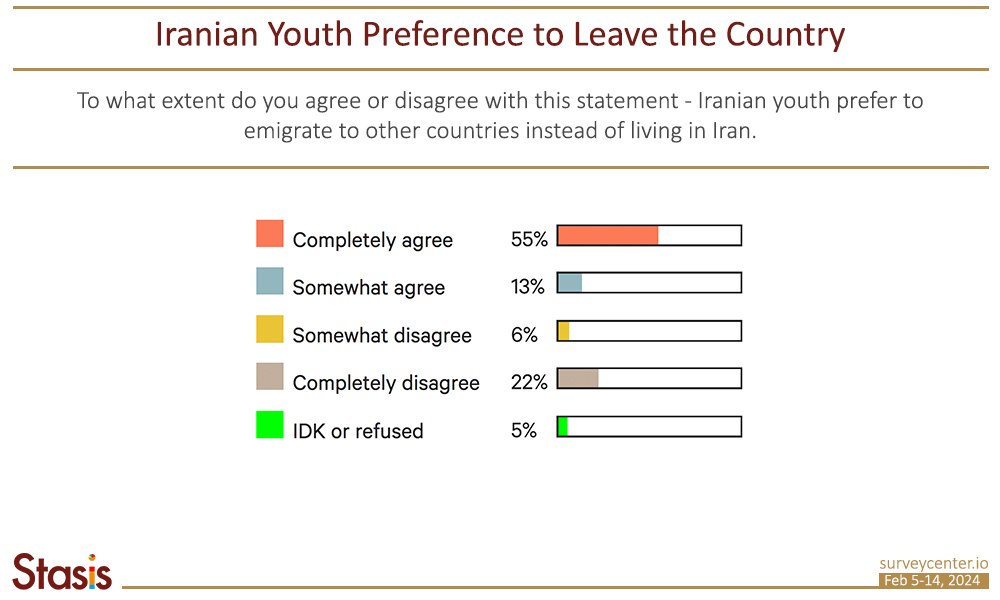
Remarks
The results of this poll have been interactively visualized in this link.
This is an interactive platform detailing the results of every question, broken down in a bar chart by gender, age group, location, and education. For each question, there is also a bubble chart (consisting of many small circles), detailing the respondents’ information. Each circle represents a single respondent; clicking on any given circle will generate the complete answer set for that particular respondent. The color coding is consistent between the bubble chart and the bar chart for easy comparison.
To find likely voters and measure the participation rate, Stasis uses a proprietary, experimental likely voter model combining the results of different questions (questions 9 to 14) to evaluate which respondents are most likely to vote. Our likely voter model is explained in the survey analytical report and can be downloaded under the section “Download Report” through the link above. Moreover, the raw data will be available within 6 months of publishing the results of this survey, through the same link.
Regarding election turnout, we should keep in mind that some of the voters who cast ballots leave them blank or write in an invalid name. Iran’s electoral system counts these as invalid votes but still considers them when announcing the turnout rate. Although historically the number of invalid votes was not significant, in the last two elections — the 2020 parliamentary election and the 2021 presidential election — it was enormous. In the 2021 presidential election, 13% of the votes were invalidated. In the 2020 parliamentary election, the participation rate and number of invalid votes for major cities, including Tehran, Mashhad, and Tabriz, were so bad that they were not even announced. For this reason, and because we have no reliable data to crosscheck the possibility of invalid ballots, we cannot reliably distinguish valid votes from invalid ones or measure how these invalid votes might change the participation rate in the upcoming parliamentary election.
Charts may not equal 100% due to rounding.
Methodology
- Telephone interviews were conducted between Feb. 5 and Feb. 14, 2024, among 1,264 respondents aged 18 and older living in Iran. Native Farsi speakers conducted the interviews during local daytime hours.
- The proportional two-stage sample includes respondents from every province. Provinces have been sampled based on their population.
- Out of 1,264 respondents in unweighted data, 78% live in urban areas and 22% live in rural areas. Additionally, the sample consists of 58% male and 42% female respondents. Nineteen percent fall into the 18-29 age group, 73% in the 30-64 age group, and 8% in the 65 and up age group. All provinces except Tehran are represented in the sample by no more than ±2% of their population share. The sample for the province of Tehran is underrepresented by 4.3% in this sample.
- Results are weighted by gender, age, location (urban vs. rural areas), and adjusted for Tehran’s province, based on the Iranian national census of 2016, the 2018 statistical yearbook, and demographic predictions from Iran’s Statistical Center for the year 2024.
- Based on the sample, there is a 95% confidence that the margin of sampling error is within ±2.76 percentage points.
- Rates of respondent candor and reliability were appraised by experienced interviewers. Forty-three persons found to be lacking in these areas were removed from the sample and are not included in the final sample or in this report.
- This poll was carried out by Stasis in association with the Middle East Institute.
- Full analytical report and detailed methodology can be downloaded through this link.